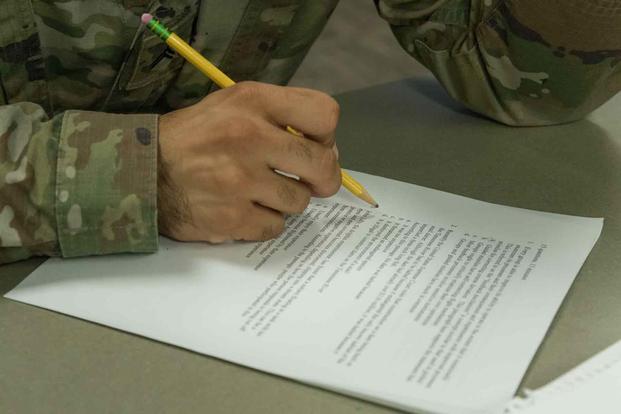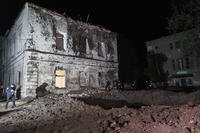The Pentagon is planning a change that will allow applicants to use calculators on the military's entrance exam -- a timed test that gauges academic aptitude and dictates what jobs in the military, if any, they are qualified for, three defense officials told Military.com.
The change in the Armed Services Vocational Aptitude Battery, or ASVAB, could help relieve an ongoing recruiting slump, which is attributed to many young Americans not scoring high enough to qualify for enlistment. It would also put the ASVAB on par with how test-taking has evolved in the past decade, with calculators being widely used in math classes and on college entrance exams such as the ACT and SAT.
"We are taking a systematic approach, which will assess the impact of calculator use, and we are developing a way forward for calculator inclusion," one Pentagon official told Military.com.
Read Next: One Soldier Dead, Another Hospitalized Amid Outdoor Fitness Tests in Mississippi Heat Wave
The Army, Navy and Air Force expect recruiting shortfalls this year, marking two years in a row that the services have failed to bring in what they consider are enough new recruits. The Marine Corps and Space Force are more isolated from recruiting woes, given the small size of those services.
The shortfalls are due to an amalgamation of issues -- but at the forefront is a shrinking pool of qualified young Americans, 17- to 24-year-olds, who are eligible to enlist. Many of those applicants are being turned away due to poor performance on the military's aptitude exam.
Last year, the Army launched its Future Soldier Preparatory Course, a two-track camp for applicants who came just shy of the service's standards for academic performance or body fat.
There, soldiers have 90 days to come into compliance. The Army can graduate about 12,000 soldiers from that course into basic training, making up much of the recruiting deficit it saw last year with enlistees who otherwise wouldn't have qualified for service.
The academic track -- applicants who struggle to hit education standards necessary for entrance -- makes up the lion's share of that course.
So far, the Army has graduated 9,216 students into basic training. Of that, 7,045 went through the academic track and 2,171 did the fitness course. During the academic portion, students raised their military exam scores an average of 18.5 points, according to data from the service.
It's unclear when calculators will be allowed to be used during the ASVAB. The internal debate in the Pentagon revolves around updating the ASVAB, a test that has stayed relatively stagnant for decades, as the ways young Americans learn and are tested in schools has continued to evolve. Part of that evolution has been wider use of calculators and other technology.
However, the move to allow calculators could result in some public backlash. One Defense Department official said some of the difficulty in crafting a policy allowing calculators has been a fear over whether lawmakers will characterize the Pentagon as lowering standards.
Republican lawmakers and some partisan commentators have increasingly bludgeoned the services as "woke" over its efforts to be more inclusive and cater to a wider demographic of service members, such as updated maternity uniforms for pregnant female troops.
Meanwhile, academic performance in U.S. public schools has steadily declined in the past decade, with the pandemic accelerating that decline, particularly in reading and math, and among students from low-income families.
Even with calculators, potential recruits could still face difficulties.
In the class of 2022, the ACT test performance -- the testing results used by colleges for admissions -- fell to its lowest levels in 30 years, with the average score being a 19.8 out of a possible 36. Less than a quarter of ACT test takers last year met all four subject area benchmarks, which are minimal thresholds that assess whether someone is ready for college.
Nearly half failed to hit a single benchmark in reading, math, science or English.
"These declines are not simply a byproduct of the pandemic," Janet Godwin, the CEO of ACT, said in a statement last year. "They are further evidence of longtime systemic failures that were exacerbated by the pandemic."
-- Steve Beynon can be reached at Steve.Beynon@military.com. Follow him on Twitter @StevenBeynon.
Related: A New Medal and Revised Marketing Tactics Part of Army's Fight Against Recruiting Slump












